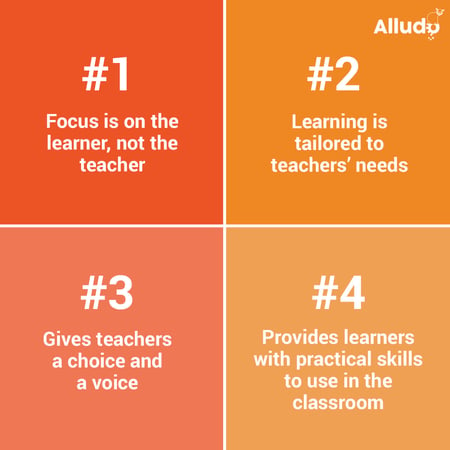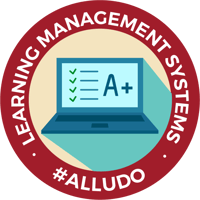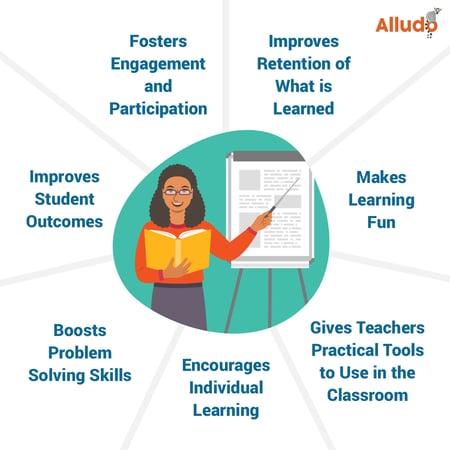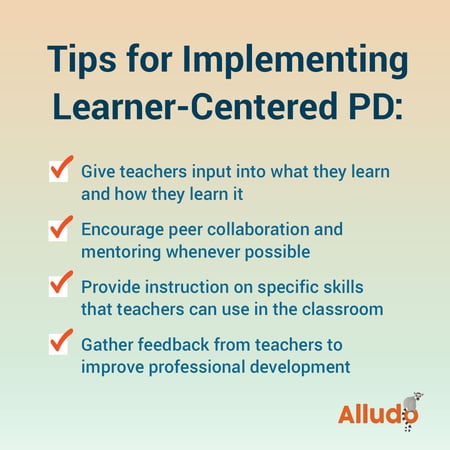Quick Tip Wednesday: How to Set Up a Gratitude Month
Welcome back to Quick Tip Wednesday!
6 min read
Damon Torgerson : Feb 7, 2022 2:00:00 PM

Study without desire spoils the memory, and it retains nothing that it takes in. ~ Leonardo da Vinci
The issue of teacher retention is one that looms large for many school districts. With teacher turnover driving a worsening teacher shortage, it’s essential for district and school leaders to do whatever they can to incentivize teachers to stay in the classroom. There are many issues that can contribute to teacher turnover but one that school districts can control is the adoption of learner-centered instruction for professional development.
At Alludo, we specialize in creating dynamic, learner-centered professional development programs that are tailored to the needs of your faculty and staff. We believe that all district employees are most likely to be enthusiastic about their jobs when they feel heard and appreciated. Here’s what you need to know about the importance of learner-centered instruction in teacher professional development.
To understand why learner-centered instruction is important for effective professional development, we’ll start by reviewing the four characteristics that typify the learner-centered ideology:

 |
 |
 |
These characteristics get to the heart of learner-centered ideology. Adhering to them can help school districts prioritize the needs of teachers to improve teacher job satisfaction and retention.
The most important thing for district and school leaders to know is that the learner-centered approach to professional development is better for teachers. Here are the ways that learner-centered PD benefits teachers.

The learner-centered approach is something that fosters teacher participation in professional development and engagement with what they learn. With traditional professional development, there’s a risk that teachers will do only the bare minimum that’s required of them.
Alludo has partnered with school districts all over the country and in every case, we’ve seen a significant increase in teacher engagement as a result of adopting the learner-centered ideology for professional development.
When teachers’ needs are prioritized and they are given a choice in what to learn, they are far more likely to absorb information and retain what they learn. That’s good news for everybody because teachers can and will bring what they learn back to the classroom.
Improving knowledge retention is something all school districts should aspire to. It leads directly to higher teacher satisfaction and lower attrition rates.
By putting teachers-as-learners at the center of your professional development program, you do something that’s hugely important for the success of your program and the achievement of your school and district goals.
The learner-centered approach makes learning fun! At Alludo, we incorporate gamification to increase teacher participation and foster healthy competition. Teachers who enjoy PD are far more likely to participate and use it to improve their performance in the classroom.
Speaking of classroom performance, learner-centered professional development gives teachers the opportunity to choose the modules that they believe will be most helpful to them in the classroom.
Introducing the element of choice allows teachers to think about what they need (and what their students need) and choose their topics accordingly. They will then bring what they learn back to their students, which can in turn increase student engagement and improve student outcomes.
No two teachers are alike. With teachers requiring different levels of instruction in any given topic, it’s essential to allow teachers to customize an individual learning plan that’s specifically suited to their needs and designed to foster professional growth.
The learner-centered approach empowers teachers to consider their needs and wants and choose the topics and levels that are ideal for them. They can use professional development to obtain new skills and strategies to optimize student learning.
One of the hallmarks of the learner-centered approach is that it encourages critical thinking and problem solving. As they participate in professional development, teachers will gain the flexibility and creativity they need to help their students.
Problem solving is a critical skill in any classroom. Since no two students are alike and teachers must adapt their teaching style to meet students’ needs, learning how to troubleshoot problems is essential.
There is plenty of evidence that adopting the learner-centered approach to professional development also improves student outcomes.
A 2021 study in Teaching and Teacher Education looked specifically at the impact of pedagogy-focused Quality Teaching Rounds, or QTRs. It found that teachers’ participation in QTR had a direct and significant impact on students’ achievement in mathematics.
Implementing learner-centered professional development in your district isn’t difficult but it does require an approach that may be different from what you have used in the past. Here are some tips to help you provide teachers with the professional development they need.

The first thing to do is to ask the teachers in your district about what they want to learn and how they want to learn it. It’s important to get information from teachers before you design a new professional development system because the information you gather will help you to address teachers’ needs.
Some teachers may be more willing to offer input than others. There’s a human tendency to resist change and this new approach may require some persuasion on your part. We have found that when teachers understand that the desire is to make professional development as useful as possible to them, they are eager to share their views and contribute to the process.
Just as student collaboration is important in the classroom – group projects, we’re looking at you – it is also essential in learner-centered professional development. A well-designed and learner-centered PD system should not only allow collaboration, it should encourage it.
Teachers are more likely to feel supported and valued when they can share their experiences with their peers and get help from them. Many school districts opt for a structured peer mentoring system to ensure that teachers have the support they need.
One of the key reasons that we specified the need for teacher input is that it provides district and school leaders with valuable information they can use to design a learner-centered PD environment. Teachers at every level can benefit from learning new pedagogies and skills.
Arguably the biggest benefit of providing instruction on specific skills is that it benefits students, too. When teachers are engaged and excited about professional learning, they’ll retain what they learn and put it to work for their students.
Getting teacher input in the design of professional development is helpful but it shouldn’t end there. Every school district should be gathering feedback from teachers after the launch of a new PD system to understand what’s working – and what isn’t.
We suggest gathering evidence of learning from teachers to evaluate and, if necessary, refine your professional development system. The information you gather should fall into three categories:
Any information you gather should be analyzed. You can use what you learn to adapt your program to meet your district goals.
The Alludo approach to teacher professional development has three primary components:
When the Jurupa Unified School District came to us looking for a solution that would help teachers adapt to distance learning and other challenges, we helped them to launch a new, personalized system of PD with thousands of micro-learning activities and the flexibility to scale as needed. The result was that 2,000+ learners engaged with the new system and have completed 30,000+ hours of professional learning.
Learner-centered instruction is designed to put teachers-as-students at the forefront of professional development. By prioritizing teachers’ needs and giving them input into what they learn, districts can maximize teacher participation and engagement and improve student outcomes.
Experience personalized learning for all levels of educators with a free trial of Alludo’s professional development platform. You’ll enjoy:
.png)
Welcome back to Quick Tip Wednesday!

Mid-Year Reflection: Your Secret to a Stronger Second Semester
A great way to get your learners engaged in your Alludo program is by keeping the content in your program up-to-date and relevant. Rebecca has...